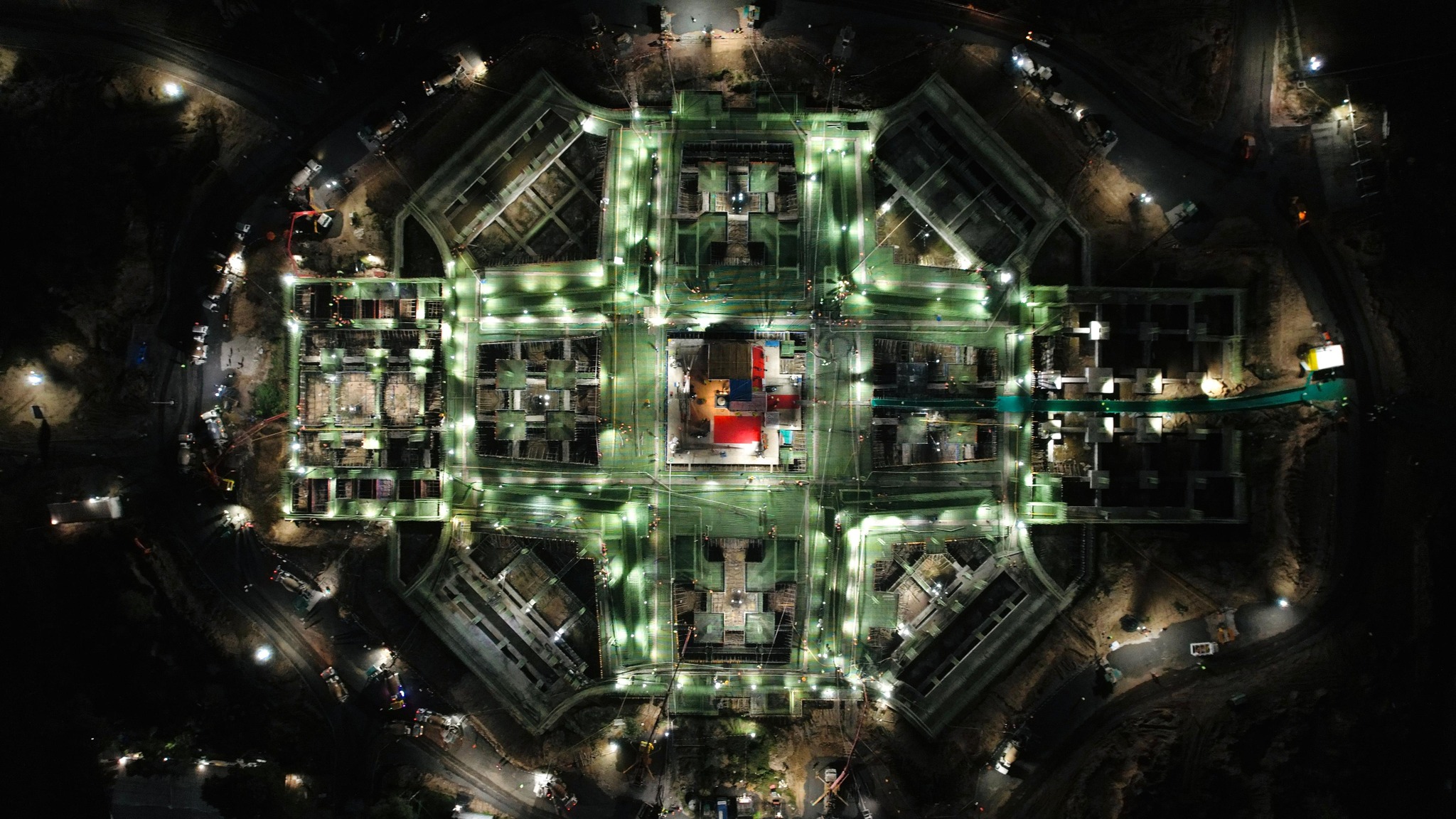Image Credit: Vishv Umiya Foundation
India’s temple architecture is reaching new heights with the under-construction Vishv Umiyadham Temple in Jaspur, Ahmedabad, where engineering excellence from Germany is blending with traditional Indian craftsmanship. Rising to 504 feet, nearly twice the height of Delhi’s Qutub Minar, the temple is being hailed as a feat of cultural pride and international cooperation.
Record-Breaking Concrete Raft
Construction work on India’s largest concrete raft, measuring 857,000 cubic feet, began on September 15 and is scheduled to conclude on September 17 in a 72-hour marathon effort. The raft uses an extraordinary 3,600 tons of cement and 4,400 tons of steel, forming the foundation of the sanctum where the idol of Goddess Umia will be placed. Engineers said the project involves continuous pouring over three days, setting a new benchmark in the country’s construction sector.
R.R. Patel, President of Vishv Umiyadham, emphasized that the project reflects both patriotism and spirituality: “This will not only be a spiritual center but a modern landmark that represents India’s capability to achieve record-scale construction with international expertise.”
Germany’s Role in Vishv Umiyadham
While the project is firmly anchored in Indian tradition, German expertise is adding a critical layer of innovation to its development.
Architectural Design: The temple’s blueprint brings together Indian spiritual aesthetics with German precision engineering, ensuring the structure respects Vedic principles while meeting global standards of safety and durability.
Lighting & Illumination: German specialists are helping design an advanced lighting system, planned to be visible for miles and capable of reflecting lunar cycles and festivals – a fusion of symbolism and technology.
Structural Safety: German engineering inputs are being applied to studies on wind resistance, load management, and long-term stability, vital for a structure of this scale.
Visitor Experience: Indo-German cooperation is also shaping modern amenities such as elevated observation galleries and crowd flow systems, making the temple more accessible to devotees from around the world.
This Indo-German collaboration ensures that Vishv Umiyadham will stand as both a spiritual monument and a symbol of cross-cultural partnership in engineering.
Features of the Monumental Structure
Built entirely of granite and white marble, the temple will feature:
- 1,551 dharma pillars sunk 65–80 feet deep for structural stability.
- A gold idol of Goddess Umia (six feet tall) and a silver Nandi.
- Viewing galleries at 270–300 feet, giving panoramic views of Ahmedabad.
- A hydraulic flagpole atop the spire and provision for easy maintenance of illumination systems.
- 27 lifts and escalators, ensuring access for elderly and differently abled devotees.
- A basement parking accommodating 2,500 cars and 10 luxury buses, with EV charging stations.
- The world’s largest Sri Yantra, spread across 8,100 square feet.
Social and Cultural Dimensions
Beyond its religious significance, the Vishv Umiyadham project also aims at social empowerment. The temple complex will include a skill university for youth and women, a hospital, a hostel, and a sports complex.
Patel noted that while the temple is rooted in Patidar identity, “it is envisioned as a symbol for all communities and for Sanatan Dharma as a whole.”
Global Recognition in the Making
Standing at 504 feet, the Vishv Umiyadham Temple will become one of the tallest temples in the world, second only to the Statue of Unity in Gujarat among the state’s tallest structures. With Indo-German architectural collaboration, modern engineering techniques, and traditional spiritual elements, it is expected to draw devotees and international tourists alike.
Rajiv Gupta, Chief Engineer for the project, underlined its uniqueness: “We are building a temple within a temple – an inner marble structure within a grand concrete frame, combining ancient design principles with German technology.”
A Landmark for Indo-German Cooperation
The Vishv Umiyadham Temple highlights how Germany’s technical expertise in engineering and design is finding expression in India’s spiritual and cultural landscape. Once completed, it will not only be a religious center but also a symbol of Indo-German partnership in architecture and innovation, showcasing how international collaboration can enhance heritage projects.



